
 Pasta is the queen.
As we were walking through our neighborhood the other night, we came upon this display in a kitchen store. I love it! Obviously, her hair is spaghetti, her skirt is made of penne pasta, the belt is coils of angel hair pasta, and her bracelet is red chili peppers.
In Italy, every region has their own pasta specialty. I found the one constant spice is red chili flakes or red chili pepper pods. Garlic, of course, is a frequent ingredient in pasta dishes, but it is not in every dish. Some pasta sauces are so delicate that garlic would overwhelm the flavor. Other bolder dishes demand many cloves of this pungent ingredient.
I started asking different local people about a particular pasta dish that is ubiquitous in Rome, a simple pasta sauce called Amatriciana. Sometimes that is spelled with 2 m’s. The spelling of the word was only the beginning of the controversy surrounding this sauce.
The first controversy I encountered was the origin of the dish. While Roman restaurants say that this is a Roman specialty, the dish actually originated in the town of Amatrici, in northern Lazio area, Lazio is the region that includes Rome, but Amatrici is a small city in central Italy in the Appenines mountain range. People of Amatrici do not take kindly to Romans referring to this as a “Roman specialty.
Then I found more controversies. Really, now, would we fight over whether to use garlic, onion, or leave them out or will we become angry If the chef tops the pasta with Parmigiano cheese versus Pecorino? Apparently, Amatricians would.
I became very careful, after that, about asking questions concerning specialties. I did find, however, that almost every Italian will be willing to beat me about the head and shoulders if I mentioned Alfredo sauce. “Non Italiano”, was the universal reply, usually accompanied by a sneer and a glare. Alfredo sauce was apparently a culinary creation of a Roman chef, named Alfredo, naturally, created by him to impress some Hollywood movie stars many years ago, Douglas Fairbanks and Mary Pickford. These two enjoyed the dish so much that they presented Chef Alfredo with a golden fork and spoon.
The closest one can get to having Alfredo sauce in Italy is pasta carbonara, spaghetti mixed with diced pancetta, raw egg beaten into the sauce , then lots of Parmigiano Reggiano cheese mixed into the pasta.
When we were in Sorrento, seafood ruled the menu, and rightfully so.
At Ristorante Delfino, I had a pasta called calamarata, as it looks like calamari rings, with shrimp, clams, zucchini, cherry tomatoes in a slightly spicy clear sauce. Frank was enjoying spaghetti alla vongole, spaghetti with clams. All sorts of seafood abound on the menus on the coast. They are so delicious, so fresh, right from the sea, and prepared by a talented chef. Antonio, at Delfino’s, is one of the best chefs in this area.
Today, we are in Florence, encountering an unsuspected rainy day, so Chef Dolly decided it was a good day to make soup. I have made many meals in this kitchen over the years, and I am in heaven having the opportunity to cook here once again.
One of the things I love about shopping for food here is that I can go to the supermarket, go to the produce department, pick up a packet of soup mix. This container will have 2 carrots, 3 or 4 stalks of celery, one or 2 small onions and some parsley, for a cost of about [euro]1. That is the starter for my soup. I then add some chicken, fennel, zucchini. At the end, I add tortellini. Now I have a marvelous soup, a perfect lunch dish for a rainy afternoon.
While we waited for the soup to finish cooking, we had a little appetizer. Frank had gone to the store, brought home a fresh baquette, still warm from the oven, and a bottle of Chianti. We had cheese, prosciutto and olives to round out the aperitivo. (An aside here: the Chianti was on sale for [euro]6. The bread cost less than [euro]1. Good wine and bread are so inexpensive here. Right now, the currency exchange rate is $1 = [euro]. 90. [euro]6 was about $6.60 )
In a future blog post, I will continue with foods of the different regions, as well as the many controversies over food preparation. Italians are very food oriented and proud of their regional specialties, so I must be sure to get my facts straight. I will try to do that as I eat my way through Italy.
Ciao for now,
Dolly
Pasta is the queen.
As we were walking through our neighborhood the other night, we came upon this display in a kitchen store. I love it! Obviously, her hair is spaghetti, her skirt is made of penne pasta, the belt is coils of angel hair pasta, and her bracelet is red chili peppers.
In Italy, every region has their own pasta specialty. I found the one constant spice is red chili flakes or red chili pepper pods. Garlic, of course, is a frequent ingredient in pasta dishes, but it is not in every dish. Some pasta sauces are so delicate that garlic would overwhelm the flavor. Other bolder dishes demand many cloves of this pungent ingredient.
I started asking different local people about a particular pasta dish that is ubiquitous in Rome, a simple pasta sauce called Amatriciana. Sometimes that is spelled with 2 m’s. The spelling of the word was only the beginning of the controversy surrounding this sauce.
The first controversy I encountered was the origin of the dish. While Roman restaurants say that this is a Roman specialty, the dish actually originated in the town of Amatrici, in northern Lazio area, Lazio is the region that includes Rome, but Amatrici is a small city in central Italy in the Appenines mountain range. People of Amatrici do not take kindly to Romans referring to this as a “Roman specialty.
Then I found more controversies. Really, now, would we fight over whether to use garlic, onion, or leave them out or will we become angry If the chef tops the pasta with Parmigiano cheese versus Pecorino? Apparently, Amatricians would.
I became very careful, after that, about asking questions concerning specialties. I did find, however, that almost every Italian will be willing to beat me about the head and shoulders if I mentioned Alfredo sauce. “Non Italiano”, was the universal reply, usually accompanied by a sneer and a glare. Alfredo sauce was apparently a culinary creation of a Roman chef, named Alfredo, naturally, created by him to impress some Hollywood movie stars many years ago, Douglas Fairbanks and Mary Pickford. These two enjoyed the dish so much that they presented Chef Alfredo with a golden fork and spoon.
The closest one can get to having Alfredo sauce in Italy is pasta carbonara, spaghetti mixed with diced pancetta, raw egg beaten into the sauce , then lots of Parmigiano Reggiano cheese mixed into the pasta.
When we were in Sorrento, seafood ruled the menu, and rightfully so.
At Ristorante Delfino, I had a pasta called calamarata, as it looks like calamari rings, with shrimp, clams, zucchini, cherry tomatoes in a slightly spicy clear sauce. Frank was enjoying spaghetti alla vongole, spaghetti with clams. All sorts of seafood abound on the menus on the coast. They are so delicious, so fresh, right from the sea, and prepared by a talented chef. Antonio, at Delfino’s, is one of the best chefs in this area.
Today, we are in Florence, encountering an unsuspected rainy day, so Chef Dolly decided it was a good day to make soup. I have made many meals in this kitchen over the years, and I am in heaven having the opportunity to cook here once again.
One of the things I love about shopping for food here is that I can go to the supermarket, go to the produce department, pick up a packet of soup mix. This container will have 2 carrots, 3 or 4 stalks of celery, one or 2 small onions and some parsley, for a cost of about [euro]1. That is the starter for my soup. I then add some chicken, fennel, zucchini. At the end, I add tortellini. Now I have a marvelous soup, a perfect lunch dish for a rainy afternoon.
While we waited for the soup to finish cooking, we had a little appetizer. Frank had gone to the store, brought home a fresh baquette, still warm from the oven, and a bottle of Chianti. We had cheese, prosciutto and olives to round out the aperitivo. (An aside here: the Chianti was on sale for [euro]6. The bread cost less than [euro]1. Good wine and bread are so inexpensive here. Right now, the currency exchange rate is $1 = [euro]. 90. [euro]6 was about $6.60 )
In a future blog post, I will continue with foods of the different regions, as well as the many controversies over food preparation. Italians are very food oriented and proud of their regional specialties, so I must be sure to get my facts straight. I will try to do that as I eat my way through Italy.
Ciao for now,
Dolly
By Dolly Goolsby – Full Story at Dolly Travels
Italy Gay Travel Resources
]]>
 When you first think of Japanese cuisine, sushi is probably the first thing that comes to mind. Tokyo is one of the best places in the world for an intense sushi #foodporn experience, mainly as a result of having the world’s largest fish market. We set out to discover some of the places to enjoy the best sushi in Tokyo and also stumbled on a few more obscure discoveries.
WHAT IS SUSHI?
Sushi is raw fish, sliced into small pieces and served on cooked vinegared rice. When it’s served without the rice it’s called sashimi. Sushi literally means, sour tasting in Japanese and comes from the old tradition of preserving raw fish by fermenting it by wrapping it in soured fermenting rice. The fish proteins are then broken down via the fermentation.
WHERE TO EAT THE BEST SUSHI IN TOKYO? – THE TSUKIJI FISH MARKET!
Tsukiji is famous for being the largest fish market in the world. Daily auctions start from 4am, drawing huge crowds. This is serious fish business. The most expensive fish (222kg of bluefin tuna) was sold here for $1.8m (155.4 million yen) on 5 January 2013.
When you first think of Japanese cuisine, sushi is probably the first thing that comes to mind. Tokyo is one of the best places in the world for an intense sushi #foodporn experience, mainly as a result of having the world’s largest fish market. We set out to discover some of the places to enjoy the best sushi in Tokyo and also stumbled on a few more obscure discoveries.
WHAT IS SUSHI?
Sushi is raw fish, sliced into small pieces and served on cooked vinegared rice. When it’s served without the rice it’s called sashimi. Sushi literally means, sour tasting in Japanese and comes from the old tradition of preserving raw fish by fermenting it by wrapping it in soured fermenting rice. The fish proteins are then broken down via the fermentation.
WHERE TO EAT THE BEST SUSHI IN TOKYO? – THE TSUKIJI FISH MARKET!
Tsukiji is famous for being the largest fish market in the world. Daily auctions start from 4am, drawing huge crowds. This is serious fish business. The most expensive fish (222kg of bluefin tuna) was sold here for $1.8m (155.4 million yen) on 5 January 2013.

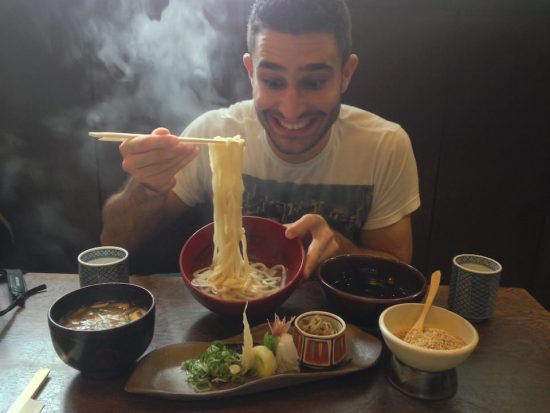 Japan is the place to come for some of the tastiest food on the planet, particularly noodles. Whether it’s the rich dreamy broth based ramen or the juicy thick yummy udon, Japanese noodles are sure to rock your world.
But when it comes to eating said noodles, what better way to show your appreciation then with several beautifully timed, loud SLURPS!? You read right. In Japan, slurping is considered good manners and a sign you’re enjoying your meal. Just take care of the splash back on your clothes…!
So, should I slurp my noodles in Japan? Absolutely – and with plenty of gusto and pride.
Japan is the place to come for some of the tastiest food on the planet, particularly noodles. Whether it’s the rich dreamy broth based ramen or the juicy thick yummy udon, Japanese noodles are sure to rock your world.
But when it comes to eating said noodles, what better way to show your appreciation then with several beautifully timed, loud SLURPS!? You read right. In Japan, slurping is considered good manners and a sign you’re enjoying your meal. Just take care of the splash back on your clothes…!
So, should I slurp my noodles in Japan? Absolutely – and with plenty of gusto and pride.
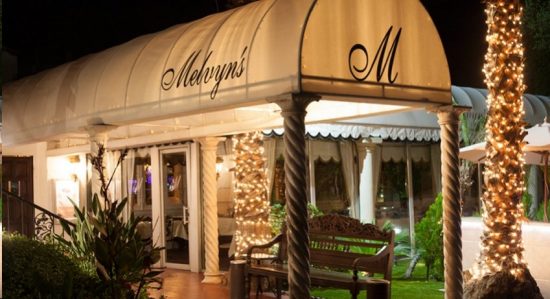 When we travel from coast to coast we usually do not know where to dine to have a memorable dining experience. Once we find a fabulous place, we go back again and again and again. We have been traveling to Palm Springs, California for 15 years and from the first time we went there we found one of our favorite restaurants in the entire country. Melvyn’s Restaurant which is located in the Ingleside Inn in downtown Palm Springs. We first heard about the restaurant on the television program, “Lifestyles of the Rich and Famous”.
When we travel from coast to coast we usually do not know where to dine to have a memorable dining experience. Once we find a fabulous place, we go back again and again and again. We have been traveling to Palm Springs, California for 15 years and from the first time we went there we found one of our favorite restaurants in the entire country. Melvyn’s Restaurant which is located in the Ingleside Inn in downtown Palm Springs. We first heard about the restaurant on the television program, “Lifestyles of the Rich and Famous”.
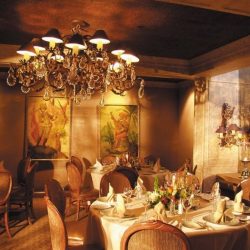
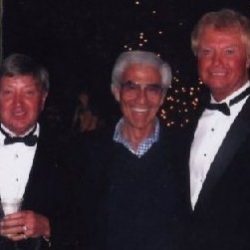



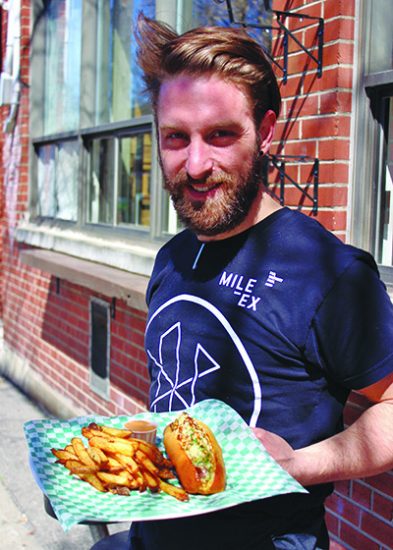 Last summer, Montreal’s Gay Village offered its customary seasonal flourish with the return of “Le Projet de Boules Roses,” artist Claude Cromier’s annual stringing of “Pink Balls” above a kilometer-plus long stretch of Sainte-Catherine Street. Part of the annual May to September Aires Libres public art event, the installation featured 200,000 balls this year, up from 170,000.
With Sainte-Catherine Street closed to vehicular traffic between Saint- Hubert to Papineau, the enhanced pink canopy provided its usual ambassadorial welcome to the summer surge of gay tourists enjoying the Village’s clubs, outdoor patios, restaurants, bars, shops, and other establishments. According to Community Marketing Inc.’s 2014 LGBT Tourism & Hospitality Survey, Montreal is an equal favorite alongside Toronto and Vancouver for gay travelers from the US, with Canada heading the list of preferred international destinations.
All would seem swell in the heart of one of the world’s most popular LGBT tourism destinations, n’est-ce pas? Well, not completely. As publicized earlier this year by the Montreal Gazette, the Village has been experiencing off-season blues for some time.
In keeping with the general trend of these technological times, the Internet is reportedly to blame, as Montreal’s younger gay crowd steers toward mobile dating applications instead of hitting the Village’s bars and clubs. As I learned from renowned Montreal journalist Richard “Bugs” Burnett, however, there is more to the story.
Last summer, Montreal’s Gay Village offered its customary seasonal flourish with the return of “Le Projet de Boules Roses,” artist Claude Cromier’s annual stringing of “Pink Balls” above a kilometer-plus long stretch of Sainte-Catherine Street. Part of the annual May to September Aires Libres public art event, the installation featured 200,000 balls this year, up from 170,000.
With Sainte-Catherine Street closed to vehicular traffic between Saint- Hubert to Papineau, the enhanced pink canopy provided its usual ambassadorial welcome to the summer surge of gay tourists enjoying the Village’s clubs, outdoor patios, restaurants, bars, shops, and other establishments. According to Community Marketing Inc.’s 2014 LGBT Tourism & Hospitality Survey, Montreal is an equal favorite alongside Toronto and Vancouver for gay travelers from the US, with Canada heading the list of preferred international destinations.
All would seem swell in the heart of one of the world’s most popular LGBT tourism destinations, n’est-ce pas? Well, not completely. As publicized earlier this year by the Montreal Gazette, the Village has been experiencing off-season blues for some time.
In keeping with the general trend of these technological times, the Internet is reportedly to blame, as Montreal’s younger gay crowd steers toward mobile dating applications instead of hitting the Village’s bars and clubs. As I learned from renowned Montreal journalist Richard “Bugs” Burnett, however, there is more to the story.
 Dallas is proud of some of its stereotypes. The “Big D” is, after all, where you’d head to find big hats and big cowboys wearing them, most of them sporting big appetites to boot. Then there’s football, another Big D, the silver-starred Cowboys. Even the classic TV show Dallas is something locals are proud to call their own, and not just for the big hats and big hair that made it the ultimate, iconic melodrama of the 1980s.
On the other hand, there are quite a few Dallas clichés ready to get bucked. Top among them is that this city is too conservative to have much LGBT culture. On a recent visit to Oak Lawn, one of the state’s, and perhaps all of the South’s, busiest gay neighborhoods, it was plain to see that queer folks are also pretty big in Dallas. Of course, where there’s a vibrant gay community there tends to be a strong dining scene. In Dallas, that’s true both in the gayborhood and around town. From staples like Tex-Mex and barbecue, to spicy send-ups and restaurants with soul, it’s time to refresh our notions about what Dallas has cooking.
LOCKHART SMOKEHOUSE
Vegetarians beware: This may not be the restaurant for you. The first tipoff are staff T- shirts that read, simply, “Wood fire meat beer.” The second is a menu that lists chick- en and turkey under “TX Vegetarian.” But for those who appreciate barbecued brisket, ribs, and other carnivorous delights, Lockhart Smokehouse delivers. This family operation is a relative newcomer having opened in the cute, walkable Bishop Arts District in 2011. Today it upholds the standard for central-Texas-style smoked meats and is considered by many to be one of the best places for barbecue nationwide.
Dallas is proud of some of its stereotypes. The “Big D” is, after all, where you’d head to find big hats and big cowboys wearing them, most of them sporting big appetites to boot. Then there’s football, another Big D, the silver-starred Cowboys. Even the classic TV show Dallas is something locals are proud to call their own, and not just for the big hats and big hair that made it the ultimate, iconic melodrama of the 1980s.
On the other hand, there are quite a few Dallas clichés ready to get bucked. Top among them is that this city is too conservative to have much LGBT culture. On a recent visit to Oak Lawn, one of the state’s, and perhaps all of the South’s, busiest gay neighborhoods, it was plain to see that queer folks are also pretty big in Dallas. Of course, where there’s a vibrant gay community there tends to be a strong dining scene. In Dallas, that’s true both in the gayborhood and around town. From staples like Tex-Mex and barbecue, to spicy send-ups and restaurants with soul, it’s time to refresh our notions about what Dallas has cooking.
LOCKHART SMOKEHOUSE
Vegetarians beware: This may not be the restaurant for you. The first tipoff are staff T- shirts that read, simply, “Wood fire meat beer.” The second is a menu that lists chick- en and turkey under “TX Vegetarian.” But for those who appreciate barbecued brisket, ribs, and other carnivorous delights, Lockhart Smokehouse delivers. This family operation is a relative newcomer having opened in the cute, walkable Bishop Arts District in 2011. Today it upholds the standard for central-Texas-style smoked meats and is considered by many to be one of the best places for barbecue nationwide.
 Sydney may have the iconic Opera house, Mardi Gras glitz, and some celebrity chefs, yet Melbourne can lay claim to Australia’s only inclusion on the World’s 50 Best Restaurants In the World list–Chef Ben Shewry’s avant-garde, farm-to-table hotspot Attica. Melbourne also has the honor of being a repeat title holder of World’s Most Livable City.
The dining scene here is simply incredible, thanks in no small part to the bounty of produce and wines resulting from the Victoria region’s climate (“four seasons in a day,” locals like to say), a burgeoning crop of under-the-radar innovative chefs, a teeming craft coffee culture, and strong multi-cultural influences.
From Melbourne’s downtown (CBD) and its famed, labyrinthine laneways to hipster hoods Fitzroy and Collingwood, amazing new spots are cropping up everywhere. Openings and reboots are routinely chronicled on chic “what’s on” website, Broadsheet, while annual tome The Age Good Food Guide keeps tabs on the best and brightest. A tastings-filled food tour is always a good idea, and the excellent and sassy Monique Bayer’s Walk Melbourne offers superb 3-hour expeditions covering coffee, chocolate, dumplings, rooftop bars, and more from $53-up. You can even try some modern Aussie cuisine from New York or Los Angeles in Qantas’ business class where the menus are by Neil Perry, whose high-profile Rockpool can be found at Melbourne’s Crown casino complex.
Sydney may have the iconic Opera house, Mardi Gras glitz, and some celebrity chefs, yet Melbourne can lay claim to Australia’s only inclusion on the World’s 50 Best Restaurants In the World list–Chef Ben Shewry’s avant-garde, farm-to-table hotspot Attica. Melbourne also has the honor of being a repeat title holder of World’s Most Livable City.
The dining scene here is simply incredible, thanks in no small part to the bounty of produce and wines resulting from the Victoria region’s climate (“four seasons in a day,” locals like to say), a burgeoning crop of under-the-radar innovative chefs, a teeming craft coffee culture, and strong multi-cultural influences.
From Melbourne’s downtown (CBD) and its famed, labyrinthine laneways to hipster hoods Fitzroy and Collingwood, amazing new spots are cropping up everywhere. Openings and reboots are routinely chronicled on chic “what’s on” website, Broadsheet, while annual tome The Age Good Food Guide keeps tabs on the best and brightest. A tastings-filled food tour is always a good idea, and the excellent and sassy Monique Bayer’s Walk Melbourne offers superb 3-hour expeditions covering coffee, chocolate, dumplings, rooftop bars, and more from $53-up. You can even try some modern Aussie cuisine from New York or Los Angeles in Qantas’ business class where the menus are by Neil Perry, whose high-profile Rockpool can be found at Melbourne’s Crown casino complex.
 Japanese food is hands down one of the best in the world. Even Sebastien, a very proud Frenchman admitted it was his favourite.
But don’t just take our word for it: in December 2013, the Japanese cuisine (called washoko), was added to UNESCO’s list of intangible heritage list. Which other cuisines do you know are UNESCO listed?!! (Sebastien was quick to point out the French cuisine is also in the same UNESCO list).
Proud Frenchman aside, after finding a great deal on Skyscanner, we decided to go to Japan for 2 weeks and visited Tokyo, Takayama, Kyoto, Hiroshima and Okinawa. So, get ready for some serious foodporn in our run down of our 10 favourite traditional food of Japan.
Japanese food is hands down one of the best in the world. Even Sebastien, a very proud Frenchman admitted it was his favourite.
But don’t just take our word for it: in December 2013, the Japanese cuisine (called washoko), was added to UNESCO’s list of intangible heritage list. Which other cuisines do you know are UNESCO listed?!! (Sebastien was quick to point out the French cuisine is also in the same UNESCO list).
Proud Frenchman aside, after finding a great deal on Skyscanner, we decided to go to Japan for 2 weeks and visited Tokyo, Takayama, Kyoto, Hiroshima and Okinawa. So, get ready for some serious foodporn in our run down of our 10 favourite traditional food of Japan.
 Dallas is proud of some of its stereotypes. The “Big D” is, after all, where you’d head to find big hats and big cowboys wearing them, most of them sporting big appetites to boot. Then there’s football, another Big D, the silver-starred Cowboys. Even the classic TV show Dallas is something locals are proud to call their own, and not just for the big hats and big hair that made it the ultimate, iconic melodrama of the 1980s.
On the other hand, there are quite a few Dallas cliches ready to get bucked. Top among them is that this city is too conservative to have much LGBT culture. On a recent visit to Oak Lawn, one of the state’s, and perhaps all of the South’s, busiest gay neighborhoods, it was plain to see that queer folks are also pretty big in Dallas.
Of course, where there’s a vibrant gay community there tends to be a strong dining scene. In Dallas, that’s true both in the gayborhood and around town. From staples like Tex-Mex and barbecue, to spicy send-ups and restaurants with soul, it’s time to refresh our notions about what Dallas has cooking.
LOCKHART SMOKEHOUSE
Vegetarians beware: This may not be the restaurant for you. The first tipoff are staff T- shirts that read, simply, “Wood fire meat beer.” The second is a menu that lists chick- en and turkey under “TX Vegetarian.”
Dallas is proud of some of its stereotypes. The “Big D” is, after all, where you’d head to find big hats and big cowboys wearing them, most of them sporting big appetites to boot. Then there’s football, another Big D, the silver-starred Cowboys. Even the classic TV show Dallas is something locals are proud to call their own, and not just for the big hats and big hair that made it the ultimate, iconic melodrama of the 1980s.
On the other hand, there are quite a few Dallas cliches ready to get bucked. Top among them is that this city is too conservative to have much LGBT culture. On a recent visit to Oak Lawn, one of the state’s, and perhaps all of the South’s, busiest gay neighborhoods, it was plain to see that queer folks are also pretty big in Dallas.
Of course, where there’s a vibrant gay community there tends to be a strong dining scene. In Dallas, that’s true both in the gayborhood and around town. From staples like Tex-Mex and barbecue, to spicy send-ups and restaurants with soul, it’s time to refresh our notions about what Dallas has cooking.
LOCKHART SMOKEHOUSE
Vegetarians beware: This may not be the restaurant for you. The first tipoff are staff T- shirts that read, simply, “Wood fire meat beer.” The second is a menu that lists chick- en and turkey under “TX Vegetarian.”
 Switzerland’s always-on-time transportation system can get you across the country on a fast train, up to the top of a mountain via ski lift, cable car, or cog railway, or around a lake for a leisurely cruise, and in many cases even provide you with a great meal in the process. Most of the country’s trains are part of the SBB (Schweizerische Bundesbahn, Swiss Federal Railway system, www.sbb.ch) and connect with local buses, local railways, municipal light rail (tram) systems, and lake and riverboats, making door-to-door travel as easy as consulting an uncomplicated schedule online or at the station.
If grabbing a quick meal on the way to catch your train or even at the station isn’t an option, remember that many Swiss trains offer onboard food service, either from an “elvetino” cart that makes the rounds several times during longer trips on inter-city (IC) and inter-regional (IR) trains.
Elvetino, an international company based in Zuerich, is a subsidiary of the SBB and provides 15 point-of-sale counters in train stations in Switzerland, about 100 mini-bar-style food carts, and 88 dining cars on Swiss trains as well as on some international routes that originate in or pass through Switzerland. Elvetino carts come equipped with mineral water, Coke products and Swiss soft drinks, bottled fruit juices, wine and beer, and freshly made coffee, decaf, and tea. A variety of sandwiches and snack foods, both salty and sweet, are also available.
Switzerland’s always-on-time transportation system can get you across the country on a fast train, up to the top of a mountain via ski lift, cable car, or cog railway, or around a lake for a leisurely cruise, and in many cases even provide you with a great meal in the process. Most of the country’s trains are part of the SBB (Schweizerische Bundesbahn, Swiss Federal Railway system, www.sbb.ch) and connect with local buses, local railways, municipal light rail (tram) systems, and lake and riverboats, making door-to-door travel as easy as consulting an uncomplicated schedule online or at the station.
If grabbing a quick meal on the way to catch your train or even at the station isn’t an option, remember that many Swiss trains offer onboard food service, either from an “elvetino” cart that makes the rounds several times during longer trips on inter-city (IC) and inter-regional (IR) trains.
Elvetino, an international company based in Zuerich, is a subsidiary of the SBB and provides 15 point-of-sale counters in train stations in Switzerland, about 100 mini-bar-style food carts, and 88 dining cars on Swiss trains as well as on some international routes that originate in or pass through Switzerland. Elvetino carts come equipped with mineral water, Coke products and Swiss soft drinks, bottled fruit juices, wine and beer, and freshly made coffee, decaf, and tea. A variety of sandwiches and snack foods, both salty and sweet, are also available.